We take on your science questions! This week, Chris Smith, Helen Scales and Dominic Ford answer your queries and conundrums...
In this episode
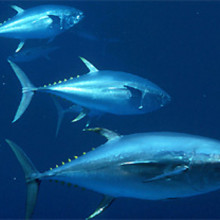
01:55 - Good and bad news for bluefin tuna
Good and bad news for bluefin tuna
New research pinpoints the favourite breeding spots of west Atlantic bluefin tuna in the Gulf of Mexico spelling both good and bad news for these imperilled fish: conservation efforts now know where to target efforts but the bluefins' spawning grounds overlap with the recent Deepwater Horizon oil spill potentially putting them in even more trouble.
 Using a combination of data on where tuna are caught by fisheries and studies that have tagged and tracked individual tunas, Steven Teo from the University of California Davis and Barbara Block from Stanford University, both in the US, built a computer model that accurately predicted where bluefins are likely to spawn based on oceanographic data gathered by satellites and weather buoys.
Using a combination of data on where tuna are caught by fisheries and studies that have tagged and tracked individual tunas, Steven Teo from the University of California Davis and Barbara Block from Stanford University, both in the US, built a computer model that accurately predicted where bluefins are likely to spawn based on oceanographic data gathered by satellites and weather buoys.
Their study, published in the journal PloS ONE showed that bluefins have a strong preference for spawning in two particular hotspots in the Gulf, where there are circular, swirling water masses called cyclonic eddies. These are cooler and more nutrient rich than warmer currents around the Gulf.
In contrast, the more common yellowfin tuna spawn throughout the Gulf and are more tolerant than bluefins to a range of environmental conditions including temperature.These differences between the two species probably come down to the bluefins' much larger size - they can grow up to 4 metres compared to yellowfins, which never exceed 2 metres. Increased activity during spawning times means bluefins can easily get heat stressed so water temperature is critical. Bluefin larvae may also be more reliant on high levels of nutrients in the water than yellowfin larvae.
All this is vital information for protecting bluefins, which have undergone serious declines since the 1970s of over 80% due to overfishing for sushi. Despite a ban on directed fishing of bluefins in the Gulf their numbers have yet to recover possibly because they are still caught accidentally by boats targeting yellowfins.
This study should make it much easier for fisheries and enforcement officers to use oceanographic data to work out where and when bluefins are likely to spawn. If a yellowfin fleet finds itself in an area where bluefins could be spawning they can pull their longlines in and move elsewhere.
Unfortunately, these bluefin spawning hotspots coincide with parts of the Gulf of Mexico at risk from the recent oil spill. We won't know for sometime how badly this will impact future generations of bluefins, which already have enough problems to deal with.
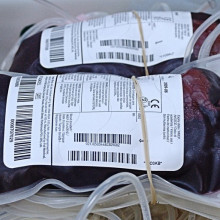
05:48 - Brains bust blood clots
Brains bust blood clots
Cells lining blood vessels in the brain can grab clots and other obstructions and dump them outside the vessel to restore blood flow, US researchers have found.
In a paper in Nature, Northwestern University scientist Carson Lam and his colleagues use a clever imaging technique (called two photon imaging) to watch what happens when fluorescently-labelled blobs of cholesterol are released into the blood vessels supplying the brains of mice. To their surprise, whenever the glowing balls of fat lodged in a small blood vessel, blocking it, within a few days it had been cleared and was sitting outside the blood vessel, almost as though a snow-plough had pushed it out of the road like a snow drift.
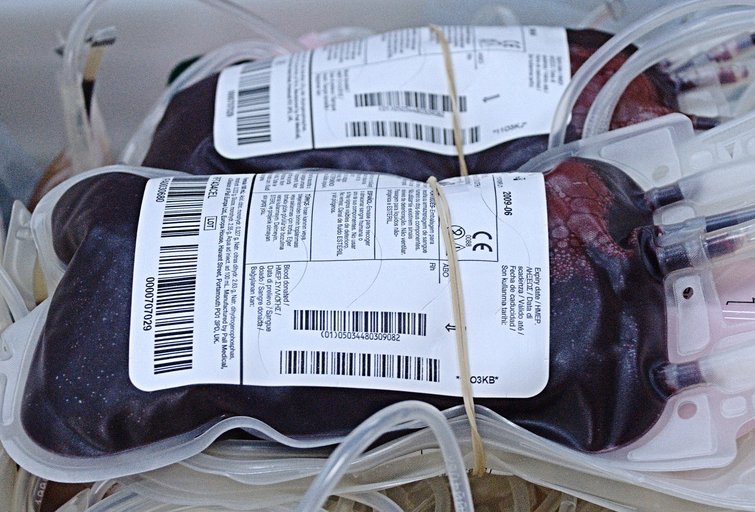 A closer look at how the process was taking place revealed that the endothelial cells, which form the linings of blood vessels, were orchestrating a sequence of events never seen before.
A closer look at how the process was taking place revealed that the endothelial cells, which form the linings of blood vessels, were orchestrating a sequence of events never seen before.
The cells were putting out thin extensions of their membranes and completely enveloping the obstruction before opening up a channel between them and their neighbours and ejecting the material from the inside of the vessel. Interestingly, when the team compared this behaviour in young versus older mice, they found that it was much less efficient with increasing age and there was considerably more brain injury as a result in these older animals.
This might help to explain in part, say the researchers, why humans succumb to deteriorating brain function as we age. At the same time it might also account for the observation that diseases like diabetes and high blood pressure - which can make the walls of small vessels much thicker - tend to increase the risk of stroke and dementia, perhaps because blood vessels damaged in this way find it more difficult to unblock themselves, leading to neuronal loss.
Clearly it's early days yet, but getting to the bottom of this observation could open up new avenues in brain protection and repair.
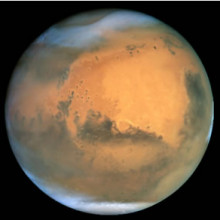
08:36 - Martian Grooves Reveal Climate Secrets
Martian Grooves Reveal Climate Secrets
Astronomers studying enigmatic grooves on the surface of Mars have uncovered secrets about the planet's historic climate. In a paper published in Nature this week, Isaac Smith and John Holt of the University of Texas Institute for Geophysics analyse new radar images of the grooves taken by the American Mars Reconnaisance Orbiter and the European Mars Express spacecraft, and they've found that beneath each of the grooves, there are indentations in all of the stratified layers of deposit down to a depth of almost 700 metres.
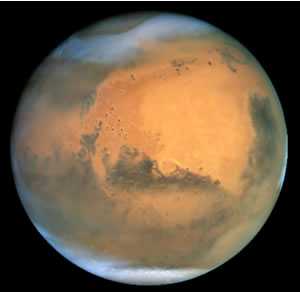 That was a startling result, because many people had thought these were merely scratch-like features carved out by erosion, extending down to a few tens of metres. We can now discard those theories as they have no way of explaining why the sub-surface geology is as much affected as the surface. A much better theory is that there is some finely-balanced combination of wind erosion and deposition at work, which is keeping the troughs remarkably stable and well-preserved as new layers of material are laid down on top of them. If that is right, then it's possible to guess the age of the features, assuming that material is deposited at a rate of around a millimetre per year, and the answer is that they must be between 500,000 and two million years old.
That was a startling result, because many people had thought these were merely scratch-like features carved out by erosion, extending down to a few tens of metres. We can now discard those theories as they have no way of explaining why the sub-surface geology is as much affected as the surface. A much better theory is that there is some finely-balanced combination of wind erosion and deposition at work, which is keeping the troughs remarkably stable and well-preserved as new layers of material are laid down on top of them. If that is right, then it's possible to guess the age of the features, assuming that material is deposited at a rate of around a millimetre per year, and the answer is that they must be between 500,000 and two million years old.
That is fascinating, because it's potentially telling us about Martian weather systems not just today, but hundreds of thousands of years ago. Smith & Holt have looked at various possible wind-driven processes which could be responsible for the grooves, and find that quite a complicated cocktail of wind erosion and particle transport is needed to keep the troughs in a steady equilibrium. Given the delicacy of the conditions required, the findings seem to preclude any recent climate change on Mars.
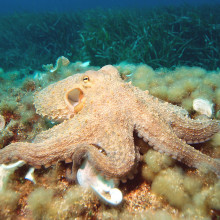
10:53 - Octopus and squid more ancient than we thought
Octopus and squid more ancient than we thought
A new fossil study reveals that the ancient ancestors of octopuses, squid, and cuttlefish have been swimming through the oceans for at least 30 million years longer than previously thought.
Originally only a single fossil of a mysterious creature named Nectocaris pteryx was found in the famous Burgess Shale deposits in Canada. And for a long time researchers were stumped as to what kind of animal it was.
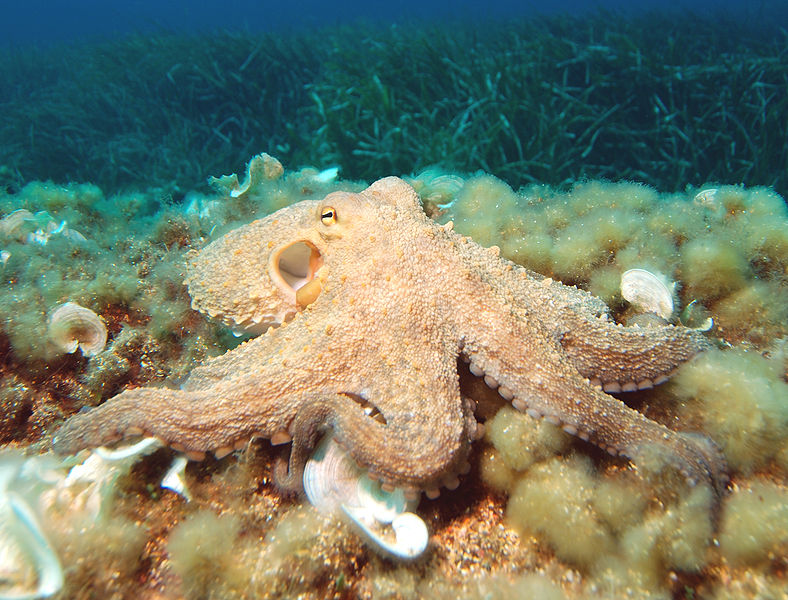 Now, writing in the journal Nature, Martin Smith from the University of Toronto leads a study that reveals a series of key characteristics that tie Nectocaris to the group of molluscs, including octopuses and squid, known as cephalopods.
Now, writing in the journal Nature, Martin Smith from the University of Toronto leads a study that reveals a series of key characteristics that tie Nectocaris to the group of molluscs, including octopuses and squid, known as cephalopods.
Over 90 new specimens have been found of the tiny creatures that were between two to four centimetres long. They had large, stalked eyes and a long pair of grasping tentacles, which they probably used to hunt for and eat prey. The researchers think they used jet propulsion to push themselves along by forcing water through a nozzle-like funnel, like many modern cephalopods do today.
Nectocaris evolved around 500 million years ago, not long after the so-called Cambrian explosion when a plethora of complex, multicellular life emerged over a short period of time setting the stage for the evolution of many groups of animals still around today.This study changes the commonly held view of the cephalopods not only because it pushes back the date when they first evolved, but it also offers insight into how they evolved into other modern and extinct forms. Nectocaris had no hard shell and it swam actively around the ocean, which goes against theories that cephalopods first evolved from ancient, bottom-dwelling molluscs with heavy, hard shells which later evolved into the floating devices found inside other cephalopods, the extinct ammonites and living chambered nautilus.
Many questions still remain about Nectocaris and the beginnings of the cephalopods but we now have a much clearer picture of what was going on 500 million years ago. We even know how some of these Nectocaris creatures died: their gills are choked in fine deposits, telling us they were probably buried in an underwater mudslide.
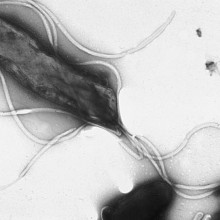
13:38 - Shape matters for Helicobacter infection
Shape matters for Helicobacter infection
with Dr Nina Salama, Fred Hutchinson Cancer Reserach Centre, Seattle
Chris - Also in the news this week, researchers in Seattle have discovered that at least as far as gut bugs go, you have to be the right shape to be a success. We knew that size was important in some context. Shape now turns out to be equally so. The bacteria in question is Helicobacter pylori and this bacteria lives in our digestive system, and it's also been linked to the formation of stomach ulcers and stomach cancer. Now intriguingly, it has a very distinctive spiral shape which scientists have thought was what helped the bacteria to survive and also move around in the gut. The new research has now shown that the spiral bacteria definitely do a lot better than if we straighten them out and make mutant forms that don't have that spiral shape. And so this suggests there might be a clue there as to new ways that we can fend off this infection. And joining us to explain how they've discovered this, from the Fred Hutchinson Cancer Research Centre in Seattle is Dr. Nina Salama. Hello, Nina.
Nina - Hello.
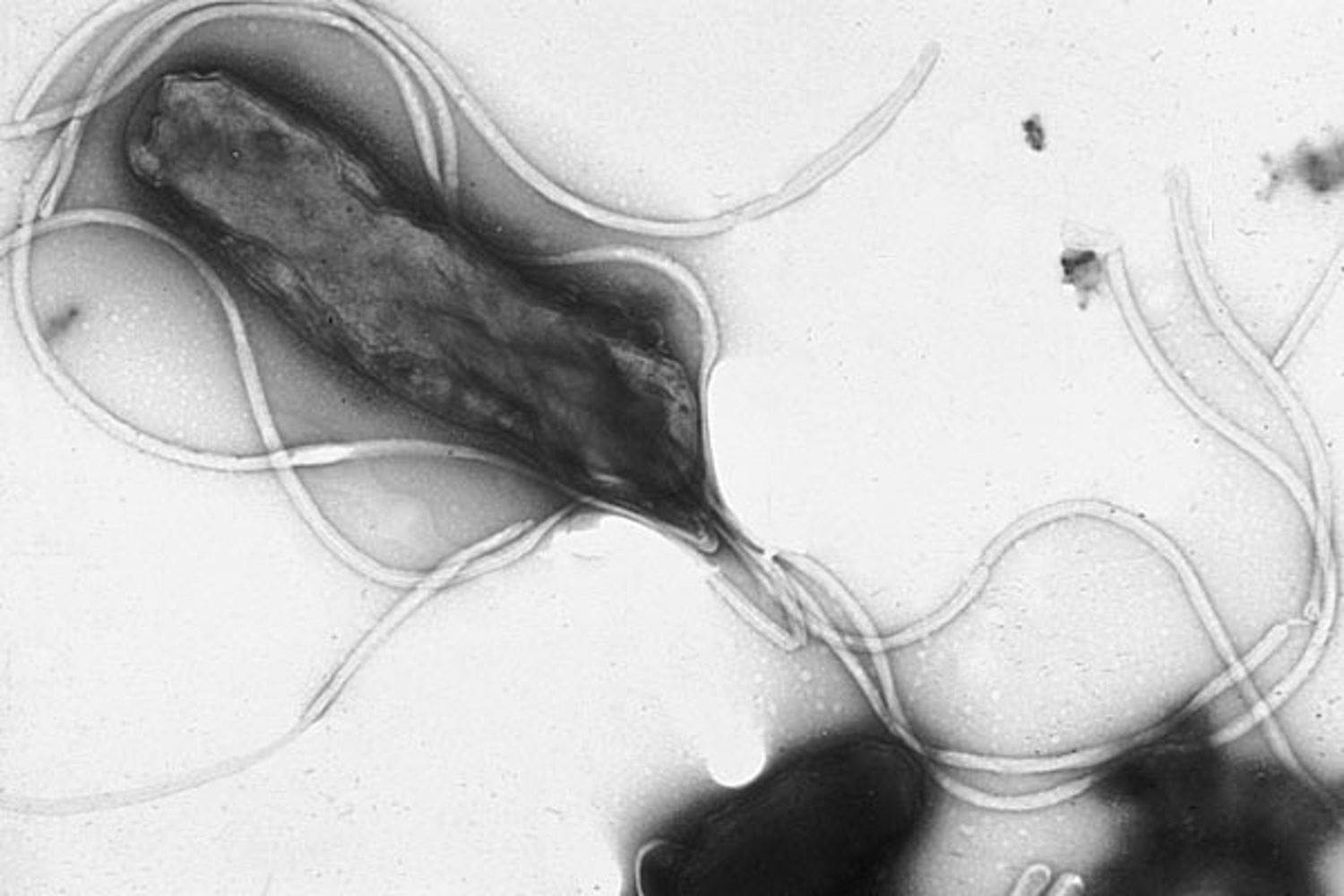 Chris - Welcome to the Naked Scientists. Tell us, if you would first of all, what is H. pylori in a little bit more detail than I went into and how does it cause disease?
Chris - Welcome to the Naked Scientists. Tell us, if you would first of all, what is H. pylori in a little bit more detail than I went into and how does it cause disease?
Nina - Well, Helicobacter pylori is a bacterium that lives in the stomach and when it was discovered in the early '80s by Barry Marshall and Robin Warren from Australia, their finding was pretty revolutionary because people thought that no bacteria lived in the stomach because of its high acidity. But these bacteria live in this very thick mucus that protects our stomach cells from the acid in the lumen and these scientists cultured them from patients with ulcers because as you say, this bacterium is associated with the development of ulcers. But it turns out that about half of the world carries this bacteria in their stomach and what it does is it causes inflammation. Most people survive with this inflammation and aren't bothered by it, but some people will get ulcers and then a smaller number of people can actually get gastric cancer, and Helicobacter pylori is the only bug at this point listed as a carcinogen by the World Health Organization.
Chris - So obviously, finding ways to make it less likely that a person will become colonised and carry the bug would be very, very helpful because it means that then there'd be less prospect of at least some people developing those stomach pathologies that you mentioned. But tell us about the shape of the bacterium.
Nina - Well as you say, Helicobacter pylori, sort of evident in its name is a helical rod shape bacteria. It looks kind of like a spiral and what we wanted to ask was whether shape really was important for it to be able to colonise in its niche, the stomach mucosa. So, what we did was look for mutant forms of the bacteria; bacteria where individual genes had been inactivated that now had lost normal shape. And interestingly, we found quite a number of different bacteria inactivated in different genes, indicating that the bacteria have a whole program to enact this shape. So the study that we just published analysed four genes that seem to work together to make this normal helical shape by modifying the cell wall and basically taking this cage which wraps around the bacteria, and gives it its shape by making little snips in that cage to make it more flexible so that it can turn into this helix and have the appropriate twist and curvature to make the helical shape.
Chris - So the obvious thing to do is to identify what those genes are, then you can go in and deactivate them. What happens to bacteria if you switch off the genes that normally make them like a cork screw shape?
Nina - It's kind of interesting. If we grow them in the lab in broth, they are just fine being grown normally, they swim normally, and they appear to be no more sensitive to stresses like acid or some of the defence molecules that our bodies secrete to kill bacteria. They seem to be just fine. But if we take them now and try to infect them into the mouse stomach because that is the model that we use since we don't do experiments on humans. Now, these strains with an abnormal shape cannot colonise the stomach.
Chris - Do you know why?
Nina - That is a really good question. We don't know exactly why. So, the previous idea in the field was that it might help with motility - the ability of the bacteria to swim out of the acid part of stomach in the lumen, down into this mucus layer and next to the cells. But what we found is that they appear to swim normally, both in regular broth and in conditions where we make a gel-like matrix to mimic the thick mucus gel that overlies our stomach and we watched the bugs by live video microscopy. We basically can't find any differences in velocity. So now, we're left to try to figure this out. So the good news is that we have this animal model where we can see a difference in the way the bacteria colonise. And so now, we're trying to go in and look where the bacteria go, how that differs from the normal spiral shaped bacteria, and try to get to the bottom of it.
Chris - And finally, Nina presumably, because you found that these genes, if they're not working and you know how they work which is helpful, they seriously disable the bug. This presumably means you can now start to look for potential drugs that could target those genes and the things that those genes make because that might be a new way to treat or potentially disable them and decolonise people who are carrying H. pylori?
Nina - Yes. In fact, a very exciting thing about our findings, is that three of the four proteins that our work uncovered appear to have a very specific biochemical activity, and that they can cleave a peptide bond. And so, having an enzyme as it were, that's functioning in your process makes it a real possibility for screening for inhibitors of these enzymes that presumably then could render the bacteria unable to colonise. And another good thing is that these enzymes aren't found in human cells so that's the other trick when you try to develop a drug against bacteria. You want something that's specific to the bacterium but that's not going to hurt our own cells.
Chris - So you can make it highly selective. Nina, thank you very much. We have to leave it there. Dr. Nina Salama from the Fred Hutchinson Cancer Research Centre in Seattle. She's published that work this week in the journal Cell.
Is there really life in outer space?
We put this question to Dominic Ford from Naked Astronomy.
Dominic - Well, it's of course very hard to know what life there is out there. People have looked for radio radiation from other civilisations using the Arecibo telescope in America and there are future telescopes that we'd hope to pick up radiation from aircraft radar and television transmitters on other planets. So far, they haven't picked up anything in the closest thousand, tens of thousands of stars around the earth. So we probably think there's not much life immediately close to the Earth but it's very hard to know what is out there.
Chris - A few years ago, in fact it was five years ago, I was in Washington DC at the AAAS conference and there was number of people at the conference talking about things like the SETI program looking for life. Some of the world's leading space scientists were right there and so we had them on a radio program, and I went along the table and said, "I'd like you all to guess or give any estimates as to the likelihood of us finding alien life within the next 50 years." Just out of interest, where would you put that number?
Dominic - I think there were a number of very interesting space missions coming up in the next 10 or 15 years which have the potential to see earth-like planets surround other stars. If we see those planets and we manage to see the light from those planets, we can take a spectrum of them and we can see what molecules are in their atmospheres. And if we start to see organic molecules in those atmospheres, we will know there is almost certainly life on those planets. It may not intelligent. It's very hard to tell whether it's intelligent, but I think there is a lot of potential to see microbial life in the next 10, 15 years. Chris - Whether or not you'd call life on earth necessarily intelligent is also open to debate. It depends where you look, I think. Dominic, thank you very much.
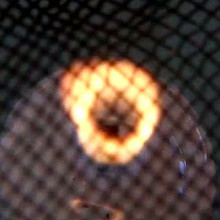
Hollow Flame - looking inside a candle flame
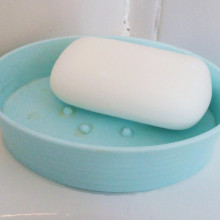
Would bacteria grow on a bar of soap?
Chris - The answer is actually, yes, they can - because soap isn't actually very toxic for bacteria. The reason that washing your hands with soap and water works so well to decontaminate them is actually the physical decontamination. When you rub your hands together, the soap helps to prise away various oils and other layers from the skin that the bacteria are clinging to and it therefore detaches the bacteria. It's not actually being necessarily antibacterial. Now some soaps will kill bacteria. The majority don't because the bacteria have got quite a tough cell wall around them, so they're resistant, but it's the physical washing that gets rid of them.
One interesting thing though, when we've had lots of outbreaks of winter vomiting disease, the norovirus, you see lots and lots of these alcohol dispensers springing up all over the place, saying, "Clean your hands. This will help to stem outbreaks of norovirus." Actually, norovirus doesn't have around its outside an oily bag which can be attacked by alcohol. It's a very tough little protein husk that the virus is made of and as a result, the virus is completely immune to alcohol hand wipes, and therefore, all you're doing when you're using alcohol is you're producing a pure culture of norovirus on your hands. Soap and water on the other hand does work. So the best thing to do, is always wash your hands. Helen.
Helen - Well that is rather lovely, but I just wanted to ask. I've always wondered. If you go to a public loo, there's a nasty bit of soap sitting on the side and you think, "Yuck!" Is it better to use that soap if it's covered in bacteria and wash your hands and rub off your own bacteria, or should you leave it alone? What do you think?
Chris - This is a bugbear of mine actually because when you go to public conveniences, the first thing you have to do to get into them is open the door of course, and the door always opens inwards. You can push the door open which means you don't have to touch any part of it. But when you're coming out again, you have to touch the handle on the door of the loo then you got to touch all over the taps, and then you've got to touch the door handle to open it and pull it inwards again.
Now okay, lots of people will be good in the toilet. They won't make a mess, but they will also wash their hands diligently afterwards. You then go out, leaving the toilet with clean hands, but you touch the door handle that the one in a million people who haven't washed their hands has just touched and decorated with a nice culture of bacteria, of faecal origin probably but also other things are possible. It's now on your hands - which were nice and clean, so there are no other bugs there to compete with them, so now you've got a nice pure culture of pathogens all over your hands.
Why are the doors are not organised so that you can push the door open on the way out or have some kind of automatic door? More lavatories these days are getting themselves organised so that you sort of go around almost like a maze to get out. But it means you don't have to physically open external doors to get out and touch surfaces because that's how these bacteria spread - it's touching surfaces. So to answer your question, you will pick up bugs when you touch surfaces including the soap dispenser and this is why in many places where medicine is done, doctors' surgeries, nurses' rooms and so on, you'll see that the taps have these long wings on them. This is so that you can actually close them off with your elbows, rather than actually having to physically touch them with the thing you've just washed. So sorry Helen, despite your best ministrations to your hands, you're probably actually picking up bugs by using that grotty bit of soap, I'm sorry to say.
Helen - I'll just have to keep my elbows clean by the sound of it.
How few individuals is too few to save a species from extinction?
Helen - That's a really good question and it opens up an awful number of issues to consider, but we can certainly just get into that to some extent.
I think my first question will be, what do we mean by saving the species? Are we talking about them persisting in the wild? Do you want to keep them in captivity? Those will require very different numbers of individuals within a population. But also, we're talking about genetic diversity and one thing you can think of is that when a population is cut down, when it declines, you do get the problem of inbreeding and that's what we're really hinting at.
If there's not enough genetic diversity, you might get inbreeding and you might actually have the appearance of deleterious genes coming together and causing problems in the animals that are being born. But that said, there have also been situations where we've thought that maybe genetic diversity is the reason why some wild species are not doing so well, when in fact, it isn't, one example is the cheetahs. We think that historically they went through a very big bottleneck, these lovely, very fast running cats that run around in Africa, and there were various studies that pointed towards genetic diversity as the problem. Things like, they could take skin grafts from any cheetah and put it onto another one and it wouldn't be rejected. So conservationists began to think, "Aha! It must be this lack of genetic diversity which is why we're not seeing enough new baby cheetahs surviving in the wild."
In fact, this wasn't true at all. It was a glitch in the studies of those skin grafts that meant it wasn't anything to do with genetic diversity. It was because lions were eating the baby cheetahs and I think hyenas as well. They were being predated upon by other animals, and when they were in areas where they weren't, they were doing fine. So, it's a tricky thing to think about. You can also think about the island of Madagascar, which was colonised by just a handful of different mammals. So they had very low genetic diversity. It doesn't necessarily mean a species is going to go extinct. It's all about lots of different factors that affect whether or not it's going to survive in the wild which I think is what really we're talking about - are they going to survive and can we try and stop extinctions from happening? There are lots of things we have to consider.
Chris - And as we heard last week when we were talking about Tasmanian Devils, actually being a bit inbred can be dangerous for another reason. You can get something happening to a population similar to the Devils. They have a line of cells which had become cancerous, and they can then go from one animal to the next, almost like an organ graft. This is accepted and not rejected by the immune system of the recipient because they're so inbred. There are dangers of a dwindling population.

Would a metal sphere containing a vacuum float?
We asked Dominic Ford from Naked Astronomy.
Dominic - Yes, it certainly would be. What's important is whether the average density of the sphere plus whatever is inside it is greater or less than the density of the water that it will be floating in. So for example, a ship floats because although a ship is made of steel and that's very heavy, it's got air in there as well and the air is much less dense than the water it's floating in, so a ship as a whole floats.
Now, if you take a sphere, the metal outside of the sphere will be much heavier than the water, but because it hasn't got anything in it, that doesn't contribute to the density. So its average density be quite low. So it will float. It will actually float better than if you filled it with hydrogen or helium which, although they are lighter than air, they still have some mass to them, more than the mass of the vacuum which is nothing at all.
Chris - Indeed. It's a good party question that, isn't it? Which is going to float more, a sealed barrel full of air, a sealed barrel full of hydrogen, or a barrel with a vacuum? Most people will go for the hydrogen, but, actually, it's the vacuum that floats the best!
Dominic - Yes, of course. You don't see barrels "filled" with vacuums very often, because it's so hard to suck air out of a barrel!
Why is bird poo white?
Helen - Excellent question and it's not actually anything to do with what they eat which is one thing you could think of - well maybe they eat something that's white? but no. They eat just the same stuff as all sorts of other creatures, but it's about how they process that food and it's all about proteins and nucleic acids, and how they break that down. We break down proteins and we all produce ammonia, but we make it into urea which we then dissolve in water and get rid of it in urine. But we need lots of water to do that, so that means we have to drink a lot which means we don't really survive very well when there's not much water around.
Birds and reptiles have a better way of dealing perhaps with low water, and the need to get rid of all that nasty toxic ammonia, and they create something called uric acid which is a solid or a mostly solid paste. That is white, and that's why their poo is white. In fact, it's very valuable stuff. Guano has been mined in lots of parts of the world to be used as fertiliser and wars have been fought over it because it can be used to make gunpowder - it's got very high nitrogen and phosphorus in it. So, there you go - white bird poo has lots of rather extraordinary applications.
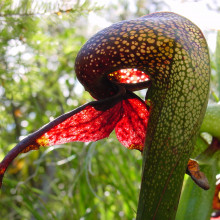
34:20 - RHS Chelsea Flower Show 2010
RHS Chelsea Flower Show 2010
with John Burton, World Land Trust; David Tight, Hampshire Carnicorous Plants; Paul Harvey-Brooks, Bradstone Biodiversity Garden
Chris - Well now, it's time to join Meera Senthilingam who's been off enjoying the sunshine this week at the Royal Horticultural Society's Chelsea Flower Show and she's been finding out how to save the rainforest and entice lots of wildlife into her garden...
Meera - Here in the UK, it's been brightening up. It's a lot hotter, which means that all of us are out and about, getting our gardens ready for the barbecue season. Now the highlight of any horticulturists calendar is the Royal Horticultural Society's Chelsea Flower Show. One particular concern being addressed is the destruction of our rainforest. So I'm now in a beautiful stand, sitting in a lovely wooden hut with John Burton who's the CEO of the World Land Trust.
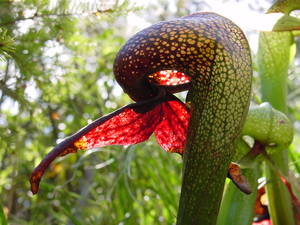 John - The exhibit we've constructed here shows at one end simulation of what the rainforest can look like - a lush, dense forest. Then we have the ranger's hut, including a window, opening on to a plasma screen and actually a live webcam transmission from the forest. So what people are seeing is what's actually going on in Brazil right at this moment. And then the other side of the ranger's hut, we've got a little garden with a tree nursery showing how we grow the trees for reforestation projects, and also, the sort of tropical plants that people don't realise, without those tropical forest, we wouldn't have some of these plants - the sweet potatoes from Paraguay, the tomatoes from South America, the chilli peppers, the pineapples. There are so many of our foods that we just accept because we get them in the supermarket. But without the tropical forest, we wouldn't have them.
John - The exhibit we've constructed here shows at one end simulation of what the rainforest can look like - a lush, dense forest. Then we have the ranger's hut, including a window, opening on to a plasma screen and actually a live webcam transmission from the forest. So what people are seeing is what's actually going on in Brazil right at this moment. And then the other side of the ranger's hut, we've got a little garden with a tree nursery showing how we grow the trees for reforestation projects, and also, the sort of tropical plants that people don't realise, without those tropical forest, we wouldn't have some of these plants - the sweet potatoes from Paraguay, the tomatoes from South America, the chilli peppers, the pineapples. There are so many of our foods that we just accept because we get them in the supermarket. But without the tropical forest, we wouldn't have them.
Meera - What's the key message that you're trying to give to visitors this week?
John - Well I think the key one here is that everyone thinks of the rainforest in terms of the Amazon - and yes, 30% of the Amazon has been destroyed, but when you put that in the perspective of the Atlantic rainforest, the Mata Atlantica, where 93% is already gone it gives you an idea of what the real losses are. And some 40% of the species found in the Mata Atlantica are endemic to that region. So we've got a real problem.
Meera - What are the main ways you're going about addressing the problem?
John - Well there's two ways. One is buying up existing forests and putting that under strict protection and the other is buying land between protected areas, creating corridors where it may have been cleared in the past and doing reforestation projects on them. You have a variety of ways of doing it - if it's only been cleared fairly recently, just by leaving it alone, it'll often regenerate. Other areas cleared a long time ago will need more regeneration, we will need to do some planting. For instance in our Brazilian project, they used 60 species of trees. They concentrate initially on some of the fast growing ones because one of the big problems is getting them going. There's often African grass which is very invasive. It is difficult for the trees to break through that. So you need to create shade as quickly as possible. So we used the fast growing species, they provide the shade for the slow growing species, timber species, to grow eventually.
---
Meera - Now I'm just walking through the grand pavilion and there's a selection of plants that sort of really caught my eye, and that's the stand of the Hampshire Carnivorous Plants. They vary greatly in their appearance. Some of them are up to a metre in height. They're tubes and some of them bend over almost with swan heads. With me is David Tight who's manning the stand. So what type of carnivorous plant are these?
David - What we've actually got is a selection of carnivorous plants from around the world who have various methods of attracting flies usually by nectar, sometimes by pattern. The plant produces a nectar on its lid. The flies are attracted to that and the colouration of the plant, and what will happen is the nectar is a slightly narcotic, intoxicating juice which clogs up the fly's fleet at the same time while it's partying on the lid. It'll get drunk, it'll fall in the tube eventually, once it gets round to the sweet spot and can't hang on, whereupon, it's constantly digested for the next three months over the course of the summer.
Meera - So how does a plant go about digesting it once the fly has fallen in to the trap?
David - What it needs is the vibration and the movement. At which point, it releases an enzyme through the wall of the tube on the inside. That's very similar to the enzyme within our stomach which breaks down the soft tissues in the fly, that the plant then reabsorbs through this walls of the inside of the tube.
Meera - Therefore, getting its nutrition.
David - Right. Trace elements absorbed, plant has a sleep through the winter, wakes up again next spring and does it all again.
---
Meera - The theme of this year's show is biodiversity, due to it being the international year of biodiversity. So what more fitting, than the Bradstone biodiversity garden! So I'm now here with Paul Harvey Brooks who designed this garden. So Paul, how in a space of 7 metres by 5 metres do you get the maximum biodiversity possible?
Paul - Well the very definition of biodiversity is the number of species within a given space and here, we've tried to literally cram in as much as we can whilst making it very beautiful. We've got lots of floriferous plants that are nectar rich. They're very simple; the colours that insects really like and then we've finally have added into the way the garden's landscape features that are particularly of interest to certain birds and animals.
Meera - We're currently sitting in a wonderful pillared porch towards the back of the garden and I can see a wide array of flowers in front of us. So what particular flowers have you chosen and what array of insects have been attracted by them?
Paul - In the flowering part of the garden, it was more of the colour and the structure which is important. The colours that we're looking at are the kinds of colours that insects are particularly attracted to and that's from research carried out at Sheffield. We see the colour as these rich mauves, lilacs and yellows, and obviously, insects are seeing them in UV light so it's different for them. And then we looked at plants that kind of give shelter, give food, and things like the hedge where we've left the top slightly shaggy is particularly important for starlings and blackbirds because they won't nest in a perfectly flat hedge and directly fly into it. They need to roost first and then fly in. So if you don't have a tree, a hedge where you've got this kind of loose shaggy approach is much more beneficial.
The other thing we've looked at are things like crevice nesting birds. House sparrows in particular have declined by about 70% in 20 years and it's simply because we don't build in a vernacular fashion and we certainly don't keep older buildings as untidy as you could do to allow them to nest. So we've made what we believe to be a very beautiful portico and you would find the crevice nesting bird there after a couple of years of it kind of settling in.
Meera - And as well as birds, what else have you managed to attract?
Paul - We've had damsel flies, we have blackbirds, blue tit, bees, honeybees. It's just been a myriad but you know, a long term approach, this garden would also be attracting small mammals like hedgehogs.
Meera - Now you also have a log wall here. So what's that all about and how is that improving biodiversity?
Paul - Well, in the urban garden, staghorn beetles are particularly prevalent or at least they were up until very recently when we became very tidy. And so, what we wanted to do was create a kind of decomposing log wall, so the top layer is fresh logs and the bottom is really rotten and the staghorn beetles lay their eggs there. The larvae actually eat the wood. So we wanted it to look good but also provide a really important habitat.
Meera - So it's really doing its job?
Paul - Well I think so. People have been very complimentary and we've seen insects around. In a way, a garden without all of this wildlife is fairly soulless. For us, it's important to make it breath and the breath is the insect.
Helen - That was Paul Harvey Brooks who designed the Bradstone Biodiversity Garden at this year's Chelsea Flower Show, and before him, John Burton, CEO of the World Land Trust, and David Tight from Hampshire Carnivorous Plants talking to Meera Senthilingam about how to help our environment from the rainforest right down to our own back gardens.
Is there any connection between high tides and earthquakes?
Chris - It sounds a bit bizarre, doesn't it? To think, could the sea be causing earthquakes? But actually, the answer is, yes, it possibly could. Now it's a slightly indirect answer to this but there was a paper that came out. It was in the journal Nature and it was last June, and it was by a US Geologist who's called Selwyn Sacks and a researcher in Taiwan. Taiwan is interesting because it's got a very, very rapid rate of tectonic plate movement. Plates there are moving and colliding at the rate of about 15 centimetres a year which is a huge amount of movement. This means that where you have faults, you have enormous amounts of energy being stored up. So, Selwyn Sacks and his colleagues were measuring strain energy. They were putting strain gauges into the ground there to measure how these faults are moving and storing energy over time. What they were really surprised to see were some rather weird recordings on their strain gauges at certain points, and what they found is that they were seeing the arrival of typhoons - these big tropical storms associated with very low pressures.
Normally, when a low pressure moves in over land, what happens is that the low pressure makes the land swell up a bit. So their strain gauges were recording that the land was swelling up. But sometimes, instead of the land swelling up, they actually found the land shrinking and the only way they can explain this is if there's been an earthquake - a so-called slow earthquake.
What's going on, it turns out, is that when you have a very low pressure system, the air pressure drops, so the land swells, but where there's sea, which is adjacent to the land of course, because the water doesn't get out of the way, water doesn't swell, instead, more water comes in to fill the area with low pressure. So this means the pressure on the sea floor is roughly the same, but the pressure over land is lower, and therefore, any faults open up for this reason because you've now got a pressure differential between the land and the sea, and this is more likely to unload faults and trigger earthquakes.
What they found is possibly happening in Taiwan is that you've got these so-called slow earthquakes which are earthquakes that happen over hours to days; they don't go all of a sudden. They gently let go of the energy and this slowly dissipates the stored energy in the fault, but the thing that was triggering it, they found on their recordings was the arrival of these typhoons, and the typhoons are basically making the tide come in metaphorically. So, I guess you could say that the movement of large bodies of water can potentially trigger an earthquake. So the answer is, yes.
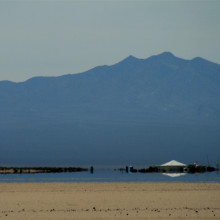
What causes a mirage in the road?
Dominic - This is interesting because we normally think that light travels in straight lines and so, when light comes into your eye, you know what direction it's come from, so you know what direction you're looking in.
But light doesn't always travel in straight lines. For example when it goes through a lens, we know it's bent and that's because the lens is made of a glass which has different refractive index from the air around it. Air also has its own refractive index which depends on the temperature of the air.
So, if you have hot air, it has different refractive index to if you have cold air. On a hot day, the sun will come down, it will heat the surface of the road and make the air close to the road very hot in comparison to the air above it.
That means that light rays are bent away from the road, and so, when you look down at the road, the rays are actually bending away from the road and back up into the sky, and you're seeing a patch of the sky in the road. Water also looks like that because water is reflecting the sky, making the sky appear in the road. So the mirage looks exactly like water...
How can you tell between different types of stellar wobble?
We put this question to Dominic Ford from Naked Astronomy
Dominic - Carol is absolutely right. Whenever a planet orbits around the star, it exerts some gravitational force on that star and that force pulls the start back and forth and that produces a red shift in the spectrum that you can then observe. You can observe it quite easily because the spectra of stars have quite narrow, well defined lines in them that you can see wobbling back and forth as the star moves. By looking at the wobble of those lines, you can deduce both the radius of the orbit of the planet and also its mass. The mass determines how far the features wobble and the radius determines the frequency of which they wobble. If you've got several planets, they will orbit with different periods and that will produce a different period of oscillation in those features. So for example, you might have an oscillation on a 10-day time scale superimposed on oscillation with 100-day time scale, just like a chord in music. By taking apart those frequency components, you can work out how many planets there are and what radius orbits they're in.
Chris - You basically have to build a model and come up with the only solution that satisfies the wobble that you're seeing.
Dominic - Yes, that's right.
Chris - It's interesting because we interviewed someone on this program called Dr. Christophe Lovis who was from the Geneva Observatory back in 2006 and he did precisely what you've just said for a star about 40 light years away from earth. It was called HD69830 and in fact, there's a very interesting interview with him on the Naked Scientists website, where you can hear a slightly different explanation for basically what you described Dominic.
Is the UV light in a sterilising lamp different to UV from a normal lamp?
Helen - Well it's all about the types of UV (ultraviolet) radiation that you've got - both in the sterilising bulb that you've got in your setup, and that's just all around us from the sun. [Sunlight] comes down through the atmosphere and contains UVA, UVB, and UVC. The most damaging form of UV is UVC, and that's what's in your sterilising bulb. It will be at a very high intensity and your water will probably get sucked through a filter and fed past this UV bulb, and that will do a very good job of killing off all those bugs that you don't want, using this very powerful form of UV light. But the UV light that's around us naturally from the sun, or even from a light bulb above your tank, that UVC will be very easily blocked by the water. Because it has such a short wavelength, it actually gets very easily disrupted and it won't actually make its way very far into the water. That's why nothing in the tank really gets affected by it. So you need that very concentrated intensive burst of damaging UV to keep the water clean, but otherwise, we do fine with the UV that bounces around in the room.
Chris - Because the stuff that we're normally seeing is a little bit of UVA, a bit of UVB, and we have an ozone layer which is really good at excluding most of the UV, including that UVC. So, in terms of sunlight, for the most part, we're protected.
Helen - Mostly protected. We still can get burned by A and B and different sun creams can help to block that, but in terms of the life that's in your tank, I think the water is enough to keep them safe from any bombarding UV light that's coming in from the surface.
Chris - Most filter systems have a little bioreactor in the bottom as well, where you have lots of bits of plastic and things with a high surface area. Good bugs, ones that you like, grow on there and then after the water's gone through the steriliser - which wipes everything out including the algal cells - it then goes through this bioreactor in the bottom of the filter which then re-seeds good bugs back into the water, as well as consuming some of the organic content which is how these filters actually work.
Helen - Absolutely.
Why can't the heart repair damage?
Chris - That's not strictly true that most things can repair if they're damaged. Some tissues can replace lost cells. So if you cut yourself or graze some skin, it will grow back. But if you have a more catastrophic injury, then without the scaffolding of tissue there to support the growth and new stem cells there to provide a supply of new cells then tissues and complicated organs cannot repair themselves. The key thing really is in the stem cells, and the heart does appear to respond very badly to injury. If you have interruption to the blood flow of the heart by blocking a coronary artery, consequently, the muscle that's supplied by that blocked artery is starved of oxygen and it does die, and the heart does not heal by repairing and replacing the lost cells in a human. Instead, the heart heals by producing fibrous tissue and you get a scar. That of course can't contribute anything to the pumping ability of the heart and so it increases the risk of things like heart failure. But not all animals are like that and in fact, researchers including Kazu Kikuchi who published a paper in Nature in January of this year, they found that zebra fish can regenerate almost a third of their heart if you cut away a third of the left ventricle, the main chamber of the heart, the equivalent of that in the zebra fish, then the zebra fish will regenerate a whole new heart, and they thought, "Well, if we can work out what they're doing, perhaps we can work out how to make humans better." They then used a specific construct so that they could turn on a gene just in heart muscle cells that labelled those cells with a glowing green colour. They then injured the heart and watched to see what happened as the heart repaired. Their theory was, well if stem cells are coming out and repairing the damage and they're nothing to do with the muscle, then the heart will just make a new muscle, and they won't glow green. If the muscle cells themselves in the zebra fish heart are repairing the damage, then you get a glowing green heart. That's exactly what they saw.
So what this tells you is that in these fish, when you injure the heart tissue, unlike in a human, the muscle cells respond to the injury by doing what's called dedifferentiating. They make themselves less specialised. They become more stem cell-like. They then divide lots and lots of times to make a big pool of cells that then go to the right places, wire themselves up and then turn back into muscle cells to repair the damage.
They have found some genes including one called GATA-4 which seems to be turned on to do this process and is also used when the heart is developing in an embryo in the first place and this suggests, if we can work out how to do this, it might be possible to trick human heart cells to do the same thing, and therefore, turn into stem cell-like cells in the heart that's been injured and therefore repair a damaged area, not with a scar, but with healthy fresh muscle again. Helen - It's extraordinary what we can learn from other members of the animal kingdom that will hopefully help ourselves in some of the problems that us humans have to deal with. Chris - Well, exactly and I think this shows you how useful having something like a little fish can be - because fish are very cheap, they're very easy to look at and these fish are transparent which means that you can grow lots of them in a little tiny dish and see exactly what's going on inside them with simple microscopy. This then informs the biology of much more complicated organs like rats and mice, and ultimately, humans. So it's making a very, very simple model of a complicated problem, and just distilling out what the crux of it is so we can hopefully find some answers.
Do sweeteners alter metabolism?
Chris - I've seen some studies where they have looked at children, and also young juvenile rats who are being fed sweeteners or normal sugar. One suggestion that some people have made - I'm not sure whether the evidence for this is robust, but it sounds plausible - is if you feed juvenile rats on sweeteners, what happens is that the brain begins to misinterpret how many calories there really are in sweet things and it gets used to the fact that when you eat something which tastes that sweet and you don't get any calories for it, if you then do get into a situation where you can eat some sugary food, real sugar, sweet stuff, you then tend to over eat because the normal metabolic gate that would say, "I know how many calories I've taken in now because when I take in this level of sweetness, I normally get this number of calories." That's been thwarted by eating the sweeteners and as a result, it can lead to overeating and weight gain, and there's some evidence that people who are on these things for longer periods as children may then develop a habit or a sweeter tooth when they're older. But as I say, I think it's speculation. I'm not sure how plausible it really is. Interestingly, there's a paper that's come out this week. It's by Jay Slack who's over in America. They're actually looking at the bitter taste associated with sweeteners because you know when you eat something like saccharin, it has an aftertaste, and they found a chemical that they call GIV3727. The reason they call it that is because the real name of the molecule is 4-(2,2,3-trimethylcyclopentyl)butanoic acid. This blocks the receptor for bitter taste buds, so you could call it a bitter blocker, and as a result, things that were bitter tasting now taste sweet. So you can associate or accompany your sweetener with that molecule, and they've done it on humans, and people stop tasting the nasty bitter taste and they only taste the nice sweet taste. Isn't that nice?
Can a moon have a moon?
Dominic - Well yes, it could. Among astronomical bodies, there's quite a long hierarchy of bodies orbiting around other bodies. Of course, the moon is orbiting around the earth and the earth around the sun. But the sun itself is orbiting about the centre of the Milky Way galaxy and that itself we think is orbiting around within a local group of galaxies, and that we think is part of a larger super cluster of galaxies. So you can certainly add another step to that hierarchy and put a body into orbit about the moon, and that is of course what we did when we went to the moon and we sent the Apollo spacecraft to the moon.
However, each step of the hierarchy tends to be less stable than the previous step. It would take something quite catastrophic to take the sun out of the Milky Way galaxy but to strip the earth out of orbit from the sun would actually be scarily easy - if a star were to pass too close to our own. Stripping the moon off the earth, we think that will probably happen on a timescale of billions of years, naturally anyway. So I think something orbiting about the moon will probably stay there for a matter of years before being shed into solar orbit.
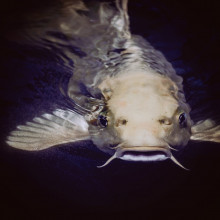
Could we 'restock' the oceans by releasing captive bred fish?
Helen - It's a very nice idea in some ways, but first of all, you have to think about the scale of what you're trying to do here. The oceans are absolutely enormous. The numbers of fish we're catching are absolutely enormous, and I just don't think we have the technology, if we even wanted to go about this if we thought it was a good idea.
We are doing some smaller scale things. Some European eels for example are being "re-stocked" and I'm saying that in inverted commas because they aren't actually being bred in captivity, they're just being moved around the place because in some areas, they're doing very, very badly, so tiny baby eels are being moved to try and restock rivers, to allow people to carry on fishing. There are things like genetic issues you might need to consider as well. What sort of species? Where are they coming from to restock them? And I think we mustn't forget that the oceans have an incredible ability to restock themselves. We just have to give them a chance.
When we take away fishing pressure from certain areas, we do see an extraordinary recovery. So we really have to focus on oceans healing themselves. I think stepping in and doing it ourselves is not the approach. It's a case of letting the oceans do it themselves and giving them a chance.
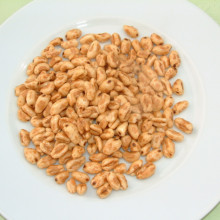
64:04 - Why do some foods make your urine smell strange?
Why do some foods make your urine smell strange?
We posed this Question to Glenys Jones from the MRC Human Nutirion Research Unit in Cambridge...
Glenys - High sugar containing cereals could make urine smell, either because they contain a compound in there when it's metabolised that has an odour or it could actually be that there's so much sugar in there, it's beyond our renal capability. Diana - So the kidneys might not be able to process all of that sugar which could lead to microbes, breeding and then creating an interesting smell. But this is quite unusual. So where else do we encounter smelly wee. Glenys - Lots of foods are known to make our urine smell. So for example, something like asparagus contains a sulphur-containing compound methyl mercaptan and another compound called asparagine and when these are metabolised in the digestive track, they release a very typical odour that people who eat asparagus will often say, that their urine smells in a particular way. Diana - But not everyone is affected by the asparagus phenomenon. Glenys - Now, whether it's because there's only half the population who contain a gene to break this down or the only half does contain a gene that can actually smell it would also explain why only a percentage of the population actually can smell this specific urinous of smell when we eat asparagus. So it might be that you can eat asparagus and produce urine that smells, but you can't smell it or it could be vice versa. Similar foods I think like cheese, garlic, eggs, and beer, they're also known to make the urine smell quite particular. The compound that is found in asparagus is also actually found in skunk secretions, so the smell that you think of with the skunk, it's the same smell that releases when you eat asparagus.
- Previous Straightening Out Gut Bacteria
- Next Ageing and our Senses
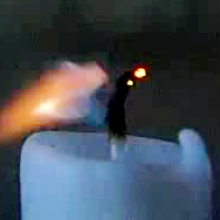









Comments
Add a comment